Gitex: The world's fastest ambulance
- Published
Mark Lobel got a close-up look at the world's fastest ambulance with one of its drivers.
This dazzling technology showcase in the desert is no oasis.
It's part of a big "smart government" programme being developed by tech-hungry emirs and tech-savvy Emiratis.
In a packed hall at Dubai's World Trade Centre, the Gulf's technology event of the year, Gitex, is taking place. This year, many of the innovations have been built to not only look good, but to do good.
Much of this year's buzz surrounds a refitted sports car, the Lotus Evora, being dubbed the fastest ambulance on earth.
It's not uncommon to see sports cars on Dubai's sand-laden streets, as it basks in its vast oil-driven wealth, and the police already own several.
Now its paramedics can also travel at speeds of up to 300km/h (185mph) and cut their response time by minutes.

This is Dubai's newest ambulance - a refitted Lotus Evora. Is this the future, or a bit of expensive window dressing?
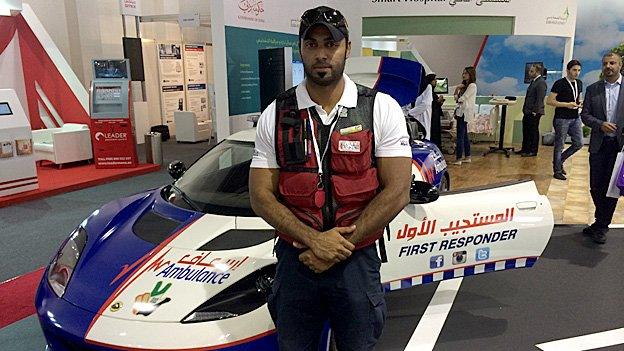
Dubai paramedic Zaid Al Mamari: "One second would be the difference between life and death"
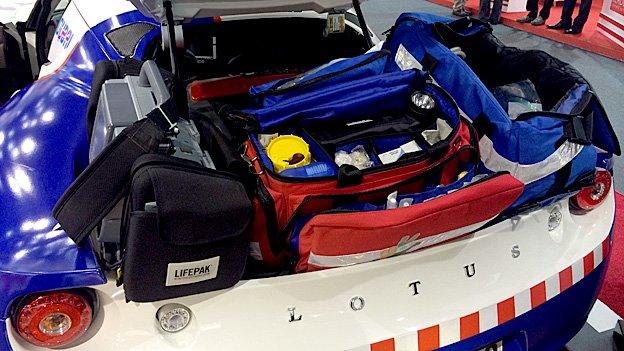
The refitted Lotus Evora is packed full of high-tech life-saving equipment
Quick draw
"One second would be the difference between life and death. Anyone who needs to be rescued will care about getting reached in a short time," one of the new car's drivers, 29-year-old Zaid Al Mamari, a paramedic with the Dubai Corporation for Ambulance Services explains.
The new fleet includes two Ford Mustangs and, soon, a Chevrolet Corvette.
Dubai's 50 paramedics will have to take driving lessons before using the $160,000 (£100,000; €125,000) car, to help them navigate Dubai's often terrible traffic. This includes Mr Al Mamari, who already owns two sports cars.
Inside the two-seater, just above a small control box for the siren and flashing light, a hard-cased widescreen notebook sits among the Lotus's lush leather interiors.
It can transmit information that the paramedics gather about the patient back to the hospital, or to an incoming crew.
A defibrillator and first aid kit squeeze in behind the driver's seat, with an oxygen supply in the boot.
Mr Al Mamari expects the cars will be used every day once they are in operation, by the end of the year - after being paraded around town for publicity.
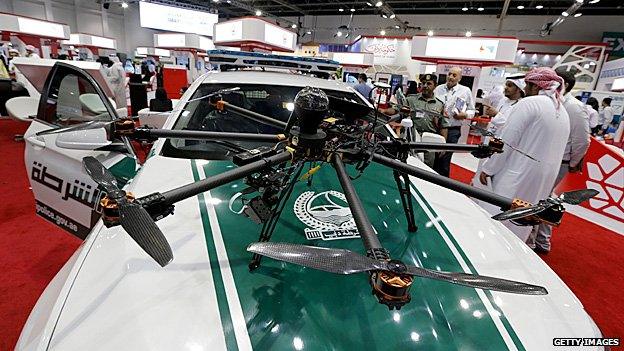
One of Dubai's high-performance police cars, with a surveillance drone perched on the bonnet
Speedy boarding
By then, millions of tourists will be visiting Dubai as the holiday season gets under way.
In anticipation, Dubai's Interior Ministry is about to launch an iris recognition system that it claims will be the quickest border control infrastructure in the world.
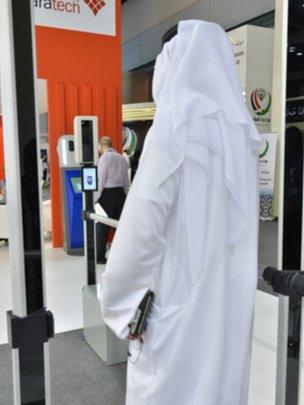
Users don't need to break their stride using the new, speedier iris recognition system
I was given a sneak preview.
The first noticeable thing is the lack of a barrier or request for ID as you approach the new machine - steps that current iris recognition systems include.
Secondly, the speed at which the many cameras scan your eyes is remarkable. You don't even need to break your stride.
"Existing software has been adapted and enhanced in Dubai with the help of our local strategic partner Emaratech," explains Captain Khalid Al Falasi, assistant general director of Dubai Immigration.
"I've only ever seen it in a James Bond movie."
Officials say any visitor will be able to register to use the system once they have finished testing it out on selected travellers.
Robot officers
The UAE has also welcomed in millions of economic migrants - who make up the majority of the population.
To help them navigate tough and sometimes complex immigration laws, officers have unveiled a human robot to answer immigration queries.
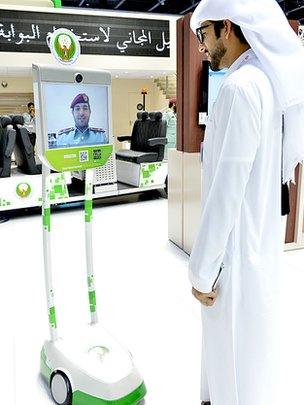
Immigration officers can travel around virtually using robots, responding to questions from immigrants
"It's the new generation of customer service employee," says Lieutenant Amer Al Mehairi, director of smart projects at the UAE's Foreigners Affairs Ministry.
Sitting in Dubai's immigration headquarters, and guided by a camera on the machine, officers will be able to use a touchscreen to remotely steer the 2m tall, three-wheeled, 70kg device.
The robot meanwhile could physically be miles away.
The officer can see and speak to customers with cameras and microphones at both ends, making this essentially video conferencing on wheels.
The robot is initially intended for airports and shopping malls, but could work in any public building with a wi-fi connection.
It has two speeds, which allows it to zip along or navigate crowds slowly, and has a rechargeable battery that lasts for 10 hours.
For some, it may be rather daunting to have an immigration officer approach you at the shops.
Others may appreciate the convenience of not having to head to an office, to have a face-to-face chat with an officer, and could find the process more relaxing.
The prototype is due to begin use, with more planned if it proves a success.

Lieutenant Amer Al Mehairi controls the robot using a touch-screen laptop
Court is in session
Parked across the conference hall from the three-wheeled robot is this year's eight-wheeled 4.5m high, 14m long showstopper.
A double-decker bus.
Like a rock band's tour bus, the inside has been totally re-imagined by its owners, Abu Dhabi's Justice Department.
The oil-rich UAE capital has spared no expense in creating a fully functional courthouse on wheels, a concept originally pioneered in South Asia.
They say they built it to both educate the public about, as well as operate within, their judicial system.
The lower deck acts as a one-stop shop for legal services.
Penalties can be paid by credit card and marriage contracts drawn up. A wall-mounted TV broadcasts live updates from ongoing court cases, and there are assigned desks for legal aid and public prosecution queries.
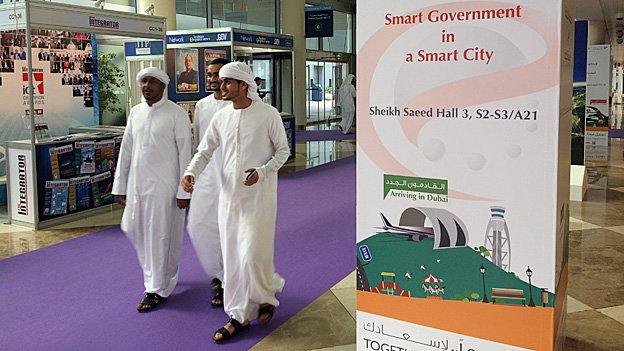
Gitex is the region's biggest technology trade show
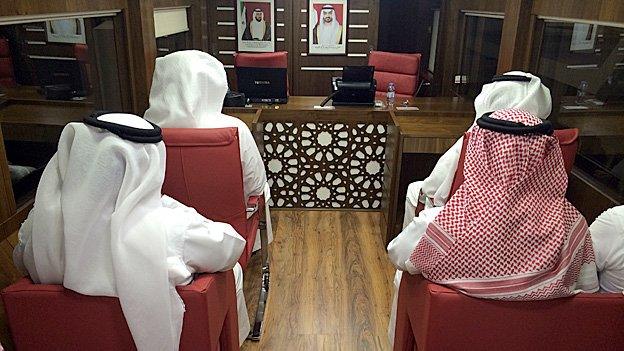
Inside the mobile courtroom
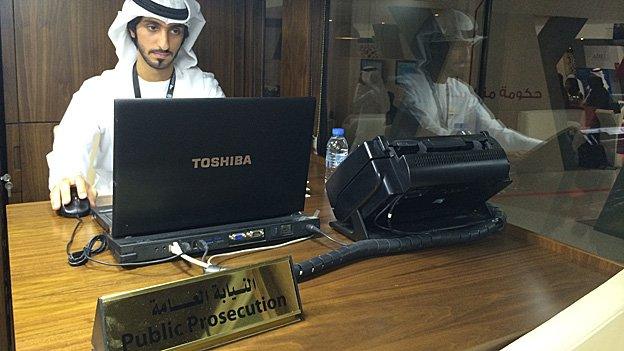
There are desks allocated to the public prosecution service and legal aid
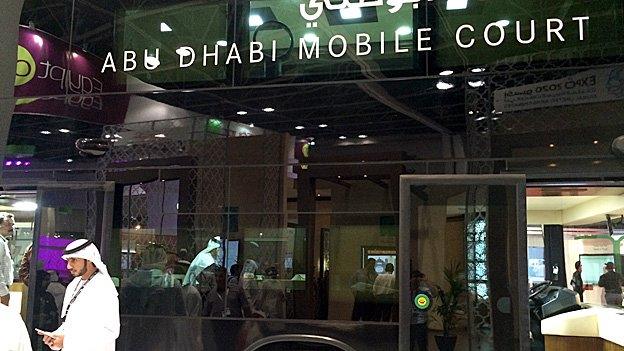
The double decker bus is a fully functional courthouse
On the upper deck there is a waiting room and the courtroom itself.
Designed by the Judicial Department's team of engineers, the room has eight polished red leather chairs for the prosecution and defendants, facing the judges' bench.
There's a hidden staircase at the back of the bus, behind a secure door, to allow judges to enter from behind their desks.
The judges' computers are connected via the internet to the Judicial Department's server, with a remote login to allow them full access to the court's entire system.
Now that the courtroom itself can travel, I ask Salah Khamis Al Junaibi, the Judicial Department's communications director, if it could help resolve long-running disputes over labour rights that some companies in Abu Dhabi have been accused of ignoring.
"If there is a case that requires a large amount of labourers, say 3,000 labourers, it's feasible to have this court at their premises, and the judge can look into this case at once," says Mr Al Junaibi.
Unlike this year's other innovations, the mobile court is unlikely to be road tested for a while.
The bus will visit communities and schools around Abu Dhabi to build awareness of the project first.